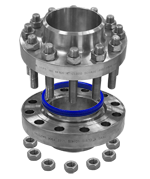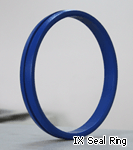 RCF NORSOK NCF5 Series
RCF NORSOK NCF5 Series
Based on NORSOK L-005 code, it is suitable for critical sealing applications with high thermal expansion, cyclic loading such as Risers, single point mooring systems, manifolds, X-Trees, subsea pipelines, heat exchangers and a multitude of process piping systems.
RCF Advantage
Space saving
Weight saving up to 70%~80% than ANSI flanges
Double independent seals make it safer
Positive sealing method
Integrated sealing system (both inside and outside)
Larger range in design temperature and pressure
RCF Working Principle
The RCF compact flange design principle is that the flange face includes two independent seals.
The first seal is created by application of seal seating stress at the flange heel. The main seal is the IX seal ring. The seal ring force is provided by the elastic stored energy in the stressed seal ring. Any heel leakage will give internal pressure acting on the seal ring inside intensifying the sealing action.

 RCF Size and Pressure Rating
RCF Size and Pressure Rating
1/2"~48" in size and CL150 to 10,000 psi (non-standard) in pressure rating. Bigger size and higher-pressure rating on request.
RCF Gasket
RCF IX seal ring, axial forces are exerted on the taper of the metal seal ring and translated into a radial sealing force. Furthermore, with increased pre-load, the bevel is closed and face to face contact is achieved at the outer wedge while most of the bolt pre-load is transferred as compressive forces between the flange faces at the heel.
RCF Design and Verification
Roc-Master provides calculation service based on ASME section VIII Division 2 and PD5500.
Also, we have ANSYS software engineers to do analysis and design verification.


